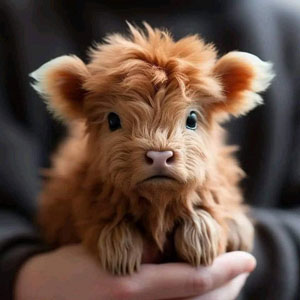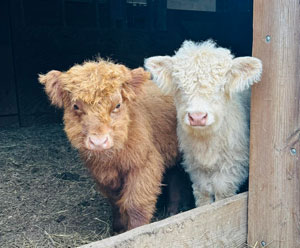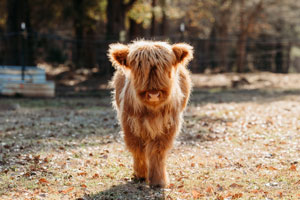
Breeding Scottish Highlands is a sacred endeavor for a Thomson family.
With their shaggy coats, docile demeanors and friendly personalities, Scottish Highland cattle are simply irresistible.
No one knows that better than Vanessa and Andrew Crawford of Crawford’s Double O Farm in Thomson. They started breeding Scottish Highlands on their 35-acre property in 2020 during covid with the purchase of Oona Rose as a birthday present for their now 10-year-old daughter, Olivia.
Since then, their home, where they had horses for 20 years previously, has become a cattle breeding farm with 20 to 25 Scottish Highlands at any given time. They have one bull for breeding purposes, and the rest are female.
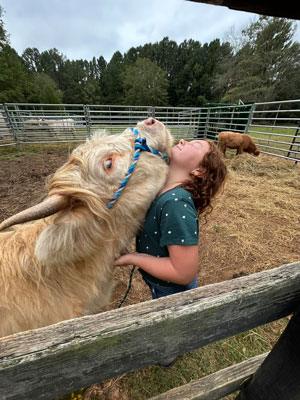 “They’re like potato chips,” says Vanessa. “You can’t have just one.”
“They’re like potato chips,” says Vanessa. “You can’t have just one.”
As if they needed any encouragement to add to their fold (the proper term for a group of Scottish Highlands), Oona Rose made sure she had some non-equine company.
“She kept getting out of the fencing and going through the woods to a black Angus farm about a quarter-mile away,” says Vanessa. “The vet said she needed cow friends, so we bought five or six more.”
Family Affair
The fold includes Freya and Willow, two 1-year-olds, who love to greet visitors by nuzzling up to them to be petted. These two girls, along with 1-year-old Opal, are permanent members of the Crawford family, which also includes their 7-year-old son, Oliver.
“We have purchased Scottish Highlands from around the country,” says Vanessa. “When we first got into this, we got older ones that nobody had desensitized. Nobody had brushed them, so they started running. We brush them to make them more docile.”
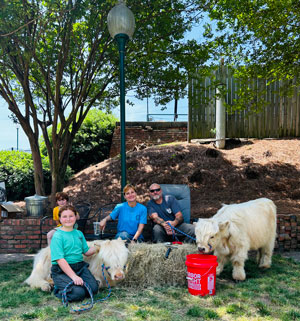 Olivia and Oliver help with the farm chores, brushing the cattle and walking the babies with halters. After getting Opal from another farm as a baby when her mother rejected her, they bottle-fed her as well.
Olivia and Oliver help with the farm chores, brushing the cattle and walking the babies with halters. After getting Opal from another farm as a baby when her mother rejected her, they bottle-fed her as well.
Unlike their children, however, neither Vanessa nor Andrew grew up farming.
“It was a dream. We love animals,” says Vanessa. “It’s not easy. There’s a learning curve with everything.”
Although Andrew also works fulltime as a blaster and Vanessa is a psychotherapist, they work on the farm seven days a week.
“One of our goals is to make this sustainable. Everything we earn goes back into the farm,” Vanessa says. “It’s rare to have a weekend off.”
If there’s anything better than living with Scottish Highlands, it’s sharing them. The Crawfords invite people to the farm to interact with the cattle for events such as birthday parties, field trips, photography sessions, picnics, overnight stays in their RV and outdoor painting sessions.
In the next Paint on the Farm event, scheduled for July 27, Augusta artist Jodi Sutton will teach people step-by-step how to paint one of the Scottish Highlands.
Currently, the Crawfords also are accepting reservations for their inaugural Scottish Highland Farm Forum in October. Topics include basic care, haltering and training, nutrition and the history of the breed.
“When we have an event, it’s all hands on deck,” Vanessa says. “It teaches our children a strong work ethic, and it’s something that bonds us as a family.”
As engaging as the cows are, it’s only natural that they’re willing props in marriage proposals as well.
 Wearing her finest pink bow and a sign that said “Will You Marry Me?” around her neck, Willow recently helped a man propose to his fiancé on the farm. The engagement ring was secured in a bucket.
Wearing her finest pink bow and a sign that said “Will You Marry Me?” around her neck, Willow recently helped a man propose to his fiancé on the farm. The engagement ring was secured in a bucket.
The Scottish Highlands love a good field trip themselves, venturing out into the world to appear in parades, festivals and cow-grams.
“We bring the cows to you like a mobile petting zoo,” says Andrew. “We take them to offices, diners and neighborhoods for cow-grams.”
The cows even accompany Vanessa, who also is a licensed wedding officiant, in virtual animal-assisted psychotherapy sessions.
“I did use equines or dogs, but people really like the cows,” says Vanessa. “They’re great icebreakers. They’re calming. Everything that animals bring into psychotherapy, the cows bring in. The cows are naturally relaxing. They’re not reactive. They communicate with their bodies. They all have different personalities.”
Amiable and Adaptable
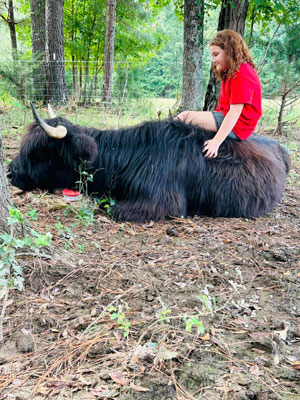 The breed not only is known for its amiability, however. The cattle also are characterized by hardiness, self-sufficiency and longevity.
The breed not only is known for its amiability, however. The cattle also are characterized by hardiness, self-sufficiency and longevity.
Highland cattle are the oldest registered breed in the world, originating from Scotland as far back as the sixth century. The harsh conditions of the rugged, remote Scottish Highlands created a process of natural selection, where only the fittest and most adaptable animals survived.
Originally, there were two distinct classes of the breed – the slightly smaller, usually black Kyloe and the larger, reddish cows. Today both of these strains are regarded as one breed – Highland. While red and black are their two primary colors, others include yellow, dun, brindle, white and silver.
“The unicorns are the silver and white,” Andrew says.
Both parents of a silver cow have a black gene, Vanessa says, and both parents of a white cow have a red gene.
Even though they have a double coat of hair, Scottish Highlands can adapt to any climate – including the warm, sunny South.
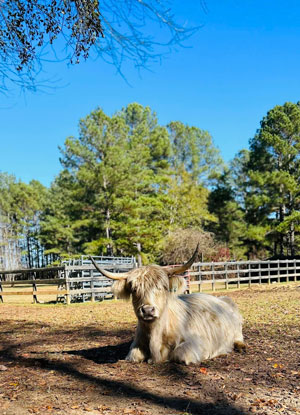 “During the summer, we run sprinkler systems and they just lay under them to cool off,” says Andrew. “Last year they kept laying on the sprinklers, so this year we have tripods.”
“During the summer, we run sprinkler systems and they just lay under them to cool off,” says Andrew. “Last year they kept laying on the sprinklers, so this year we have tripods.”
Highland cows mate any time of the year, and they are devoted, protective mothers. The cows can reproduce into their late teens, reducing the need for frequent herd replacement, and they rarely need assistance when giving birth.
“The gestation is nine months just like a human,” Andrew says.
The babies stay with their moms for four to six months, and the Crawfords put them next to each other in adjacent pastures to wean them.
They have bought cows from as far away as Canada, and the newly purchased animals always go through a veterinary examination. The Crawfords also quarantine their new cows for a minimum of two or three weeks when they arrive on their property.
“When a cow is quarantined, that gives us time to get friendly with her and get familiar with her demeanor,” says Andrew.
The Crawfords breed the animals for pets, and each of their cattle have a name. “We post pictures on Facebook and ask people to name them,” Vanessa says. “We love Scottish and nature-based names.”
They also market their cattle on Facebook, and they register them with the Heartland Highland Cattle Association and the American Highland Cattle Association. Many of their cattle are double registered.
“No animal leaves our family without a health certificate,” Vanessa says.
They enter into a contract with purchasers and give them guidelines on how to care for the cows.
“There are a lot of scammers out there,” Vanessa says. “No one should ever put down a deposit if they can’t see the farm in person or Facetime with the animal.”
Scottish Highlands also can be milked on a small scale, with one cow producing two gallons per day on average. While they don’t make as much milk as a production milk cow, they can produce enough for personal use. Their milk also has an extremely high butterfat content of up to 10%.
“If people purchase them from us, we can teach them how to milk the cows,” Vanessa says. “If they purchase from us, they can always come to us for help. We also want the first right to purchase the cow back if it doesn’t work out.”
Along with their cattle, the Crawfords have a Valais ram – a Swiss breed that is characterized by its mop top and black face – that they plan to breed with their baby doll sheep, which have no horns.
“Our cows are the most docile cattle in the world,” Vanessa says. “The sheep we’re working toward are the most docile of the sheep.”
While their breeds may be easygoing, the Crawfords are adamant about caring for their animals and running their business the right way.
“It’s important for us to have a good reputation,” says Vanessa. “This is our legacy.”
For more information, visit the Crawford’s Double O Farm Facebook page.
By Leigh Howard
